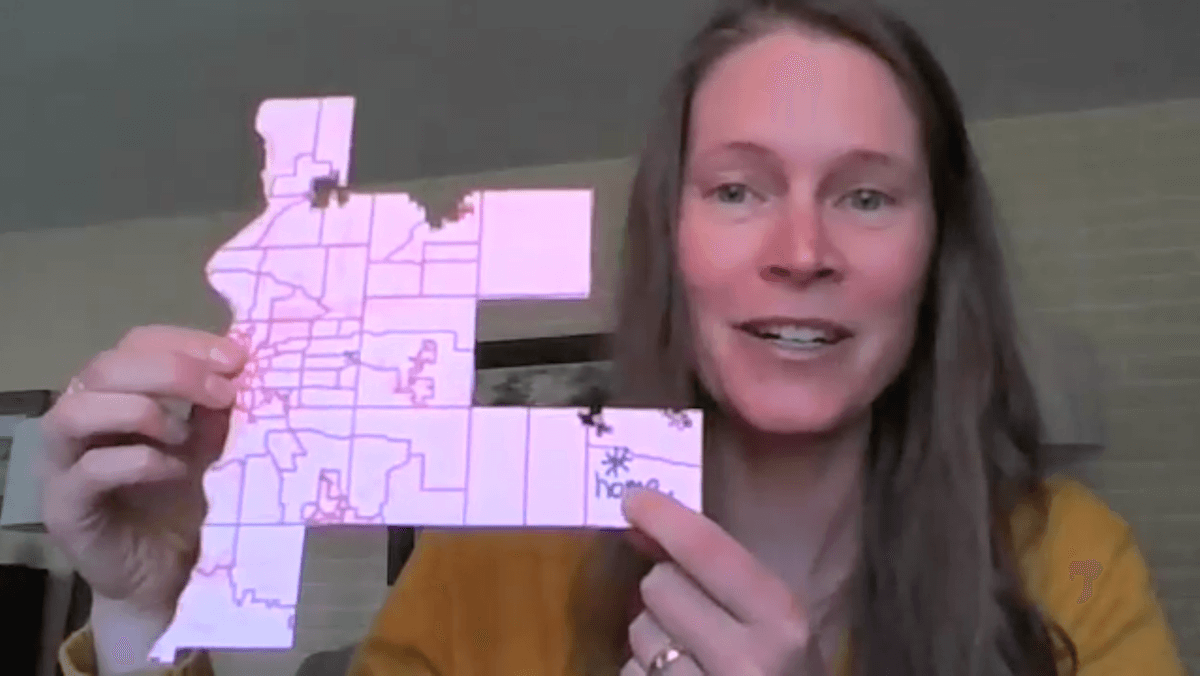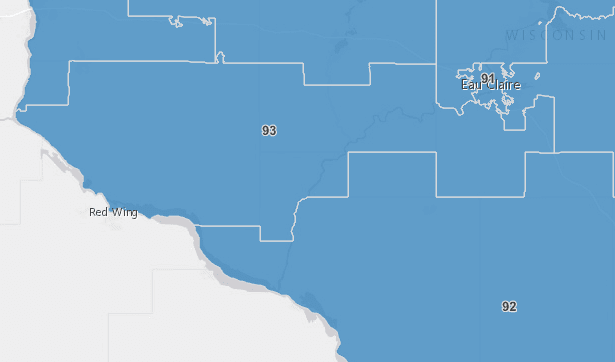
#image_title
Western Wisconsin residents who spoke against GOP’s maps proposal pointed out the strange shapes of some districts.
Until recently, Don Leake wasn’t really interested in politics; it was more his wife’s thing. Then his wife became interested in redistricting and he learned that the Peoples’ Maps Commission put out a request for people to submit maps. A retired UW-River Falls math professor, the call for maps piqued Leake’s interest.
“That’s an interesting problem because it may sound simple, but it’s really hard to do something that does justice to all sorts of different constraints that people put on the maps,” Leake said.
Leake’s interest comes as the state works to draw new political maps, which determine district lines for who represents communities in the US House and state Assembly and Senate. The process must be done every 10 years to account for population changes, and in Wisconsin, the Legislature draws the maps and the governor can either approve or deny them.
After learning more about the mapping process, Leake found he didn’t have a problem with his current Assembly District 30 (although Rep. Shannon Zimmerman’s (R-River Falls) alleged residence outside of his own district is another matter); it’s compact, competitive, obeys all the redistricting rules, and keeps River Falls all in one district.
The proposed map from legislative Republicans is another matter entirely. That’s because it was drawn using gerrymandering, a practice in which the party in power draws district lines in ways that make it more difficult or even nearly impossible for the minority party to win back power.
When Wisconsin Republicans controlled the Legislature and governorship in 2011, they drew some of the most severely gerrymandered maps the nation has ever seen and managed to lock in their control of the Legislature for the entire decade. Now, Republicans are trying to expand their control—and Leake’s Assembly district would see profound changes under their proposed map.
“It turns out that this redistricting cycle does completely the opposite of that nice district that I had before,” Leake said. “It’s less compact. It splits River Falls. It takes a competitive district and turns it into a Republican-leaning district and all for political purposes.”
Leake wouldn’t even stay in District 30 if the legislative maps are approved. The split across River Falls would move Leake’s house into District 93.
“I have called [District 93] the snake before, but as I looked at it, in the [legislative] map, I would call it the dead turtle,” Leake said. “It looks like a turtle that’s on its back.”

Keeping Communities Together
One week after Leake and more than 150 people testified for almost 10 hours before a joint committee hearing over the proposed maps, a state Senate committee approved the maps, sending them to the Senate floor for a vote. Other than Assembly Speaker Robin Vos (R-Rochester) and Sen. Devin LeMahieu (R-Oostburg), none of the commenters spoke in favor of the Legislature’s proposed maps.
Leake and Jenelle Ludwig Krause are members of Western Wisconsin for Nonpartisan Voting Districts, a collection of fair maps organizations across Western Wisconsin. Ludwig Krause made a cutout of the 30th Assembly District in legislative Republicans’ proposed map for her testimony. The 30th District is shaped like an octopus, with Hudson at the head and four tendrils going north, east, and south.
Ludwig Krause lives at the very edge of the longest tendril. Even though she said she rarely goes to Hudson, her new district would include it. Meanwhile, Baldwin and Spring Valley—the two communities she lives between and goes to frequently—would be left out of her district.
As they learned more about redistricting, Leake and Ludwig Krause noticed more and more boundaries in western Wisconsin that they believed could be politically motivated. For example, Dunn County’s entire population could easily fit in one district, but the Legislature’s proposed map has the county split up into three Assembly districts.
RELATED: ‘Nike Swoosh’ Assembly District Shows How Gerrymandering Splits Up Neighbors
“For Madison and Milwaukee, county lines don’t matter that much,” said Ludwig Krause. “But for rural places, like where we live, over and over we heard from people that their county was really important to them.”
As far as the state Senate and congressional maps, Sachin Chheda, director of the Wisconsin Fair Elections Project, told last week’s joint hearing that there’s no question the current maps and the newly proposed ones are strongly gerrymandered.
“You can argue from here until Sunday, but there’s no argument that this map is gerrymandered and the partisan considerations played the greatest role,” Chheda said. (Vos admitted partisan politics played a role in drawing the maps and defended gerrymandering as a “constitutional allowance.”)
Chheda cited a Princeton study where researchers created and examined over 1 million computer-generated, legally compliant maps of Wisconsin. Of those million maps, only 30 had the same level of partisan gerrymandering that the Legislature’s map has.
“I’m not suggesting a 50-50 map, [but] a fairer map that would give Democrats a fighting chance if the people of Wisconsin actually supported them and decided to reject the point of view Republicans put forward,” said Chheda, who is a Democrat but also opposes Democratic gerrymandering in Illinois and New Jersey. “Instead, what the Republicans do is they say, ‘It doesn’t matter what the people think. We’re just going to make sure that we’re going to have a majority, no matter what.’”
The Peoples’ Maps Commission (PMC)—the nonpartisan group that Gov. Tony Evers tasked with drawing fair electoral maps for this year’s redistricting—recently finished revising its proposed maps for the state Senate, Assembly, and US Congress.
“For years, the people of this state have asked their elected officials for nonpartisan redistricting. For years, the people of this state have demanded better and fairer maps. And for years, the people of this state have gone ignored,” Evers said in a statement when the PMC’s proposed maps were revealed. “The gerrymandered maps Republicans passed a decade ago have enabled members of this Legislature to comfortably ignore the people who elected them. The fact that Wisconsinites have asked for nonpartisan redistricting for years and their elected officials wouldn’t listen—and still aren’t—is the case in point for fair maps.”
The PMC’s final maps were given an A grade by the Princeton Gerrymandering Project, particularly for competitiveness, because they do not give either party an unfair advantage. The Assembly and state Senate maps put forward by legislative Republicans received Fs for competitiveness for giving Republicans a significant advantage.
On Tuesday, Evers introduced legislation to implement the maps and called for them to receive a hearing in the Republican-led Legislature. If a hearing is not scheduled, Evers said he would call for a special session.

Opinion: Many to thank in fair maps victory for Wisconsinites
On February 19, 2024, Governor Tony Evers signed into law new and fair state legislative maps, bringing hope for an end to over a decade of...

Opinion: Empowering educators: A call for negotiation rights in Wisconsin
This week marks “Public Schools Week,” highlighting the dedication of teachers, paras, custodians, secretaries and others who collaborate with...

Op-ed: Trump’s journey from hosting The Apprentice to being the biggest loser
Leading up to the 2016 election, Donald Trump crafted an image of himself as a successful businessman and a winner. But in reality, Trump has a long...

Not just abortion: IVF ruling next phase in the right’s war on reproductive freedom
Nearly two years after the US Supreme Court overturned Roe v. Wade, another court is using that ruling to go after one of the anti-abortion right’s...




